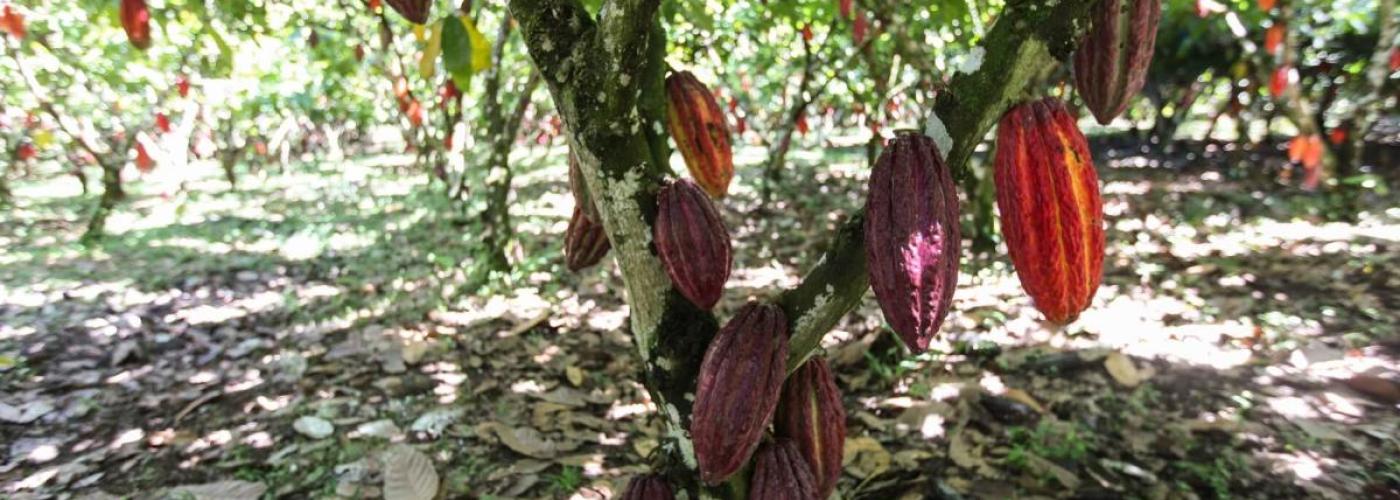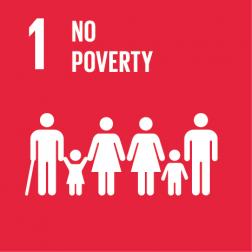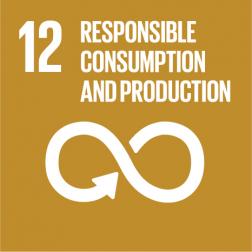The most crucial ingredient in our delicious Belgian chocolate is, of course, the cocoa beans. Almost three-quarters (72%) of Belgium's cocoa imports come from Côte d’Ivoire, Ghana and Nigeria. And this does not take place in large plantations, but by an estimated 270,000-plus cocoa farmers, each of whom has only a relatively small plot of land – often 2 hectares at most.
Extreme poverty trap
Most small-scale cocoa farmers are caught in an (extreme) poverty trap. They do not have access to water, sanitation, electricity, infrastructure and so on. On their patch of land, they harvest around 450 kg of cocoa beans per hectare and they only get a very low price for it. Moreover, climate disruption has made harvests highly unpredictable. Last season, for example, the harvests reached a dramatically low level: only 200 kg per hectare (see below).
Consequently, the farmers often cannot even cover the cost of their cultivation, let alone invest enough to increase their production. So, when they make their children work too or send them out to help elsewhere, they do so out of sheer necessity. They have no other choice! The same goes for the bit of forest they cut down to plant some more land.
So, if we truly want sustainable cocoa – free from deforestation, free from child labour, etc. – we must focus first and foremost on a living income for cocoa farmers. That means they can earn a living and run their businesses. In fact, a living income is nothing less than a human right.
Beyond Chocolate, the pioneer
Beyond Chocolate has understood that lesson well. Through that initiative, Belgium decided in 2018 – not only the government, but also chocolate makers, supermarkets, NGOs, etc. – to make all Belgian chocolate sustainable by 2030. The Belgian government asked IDH to manage the Beyond Chocolate programme.
Soon, all those involved agreed that this would only be possible if cocoa farmers got out of their poverty trap. Because once farmers can make a good living from their work, they will no longer feel the need to cut down forests or put their children to work.
Belgium was thus a true pioneer. Although Germany took a similar initiative back in 2012, and Switzerland launched a platform for sustainable cocoa a few months before Belgium's Beyond Chocolate, the Belgian initiative was the first to explicitly set living incomes as a goal. Later, both Germany and Switzerland modified their approach. Afterwards, French and Dutch initiatives emerged that also committed to a living income as a goal.

The puzzle of a living income
But how do you achieve a living income? For 20 to 30 years, there was an almost exclusive focus on productivity. In the sense that, if the cocoa farmer can produce twice as much, they will earn twice as much. Although productivity – the yield from cocoa trees – is crucial, it is only one factor in a living income! We can only get there if we take a holistic view and consider all the factors.
Below, we will provide a word of explanation for each of the income drivers – the factors which, combined, will make it possible to achieve a living income.
- Price
If you pay a higher price, you are of course having a direct impact on a producer's income. Moreover, price is a factor that chocolate companies can most easily change. A number of Beyond Chocolate signatories have understood this well. Thus, more and more companies are paying a higher price than the market price through additional premiums for the cocoa farmer. Those premiums also bring greater security for the producer. And this is quite an improvement, as the cocoa bean market faces extremely volatile prices.
Currently, the market price of cocoa – the price paid by Belgian chocolate companies – is at a record high of over $5,000, up to as much as $7,000 per ton. In 2017, the price was only $1,600 per ton. Cause: underproduction due to excessive rainfall. Because of the poor harvest, high prices are likely to persist for a while, but it is important to anticipate from now on a collapse in prices as soon as there is more production again.
As we strive to achieve living incomes, it is essential to develop strategies that can reduce the risk of price collapse for farmers. And to protect farmers if that crash does come. One way to do that is through direct premiums, because they increase and stabilise farm gate prices – the price the farmer actually receives.
Premiums are already paid through certification systems and sustainability programmes, but these are often insufficient to make a real leap in income. Additional premiums can help close the gap to truly living incomes. In recent years, for example, some Beyond Chocolate partners have already been paying a significantly higher price, called the living income reference price – Tony's Chocolonely, among others. Some supermarkets operate with a private label: Boni (Colruyt), Way to Go (Lidl), Choco Changer (Aldi) and Delicata (Delhaize).
In addition to companies, governments of producing countries also play a major role. For example, several years ago, Côte d’Ivoire and Ghana launched a joint initiative, the Ghana Côte d’Ivoire joint initiative. The underlying idea is that much attention has been given in the past to the environmental and social pillars (child labour, deforestation), but too little to the economic pillar. The two countries are now working together to ensure stable and fair prices for farmers.
- Land
In Ghana and Côte d’Ivoire, the land has to be divided among lots of small-scale farmers. As a result, they each have only a small plot of land, often no more than 2 hectares.
In addition, they often have no prospect of long-term use of the land – 60-70% are tenants – so they do not see the point of investing extra in it (see “Volume”). Solid land use rights are thus essential. They can be achieved in collaboration with local governments.
- Volume
Obviously, income is partly determined by the volume of cocoa beans that the farmers can harvest. And that volume depends on productivity: how much yield do they get per hectare? From when is cocoa production profitable?
To illustrate: in West Africa, most cocoa farmers harvest about 450 kg per hectare, while a well-managed plantation should be able to yield 800 kg per hectare. In Latin America – albeit with different varieties – they even reach 1,000 to 1,500 kg per hectare.
Due to heavy rains, West African farmers only achieved 200 kg per hectare last season, which was exceptional. This low harvest is partly due to the fact that the heavy rains affected the cocoa trees, which therefore produced fewer flowers and were damaged by viral and fungal diseases.
Higher productivity would therefore lead to greater profits. Driving up productivity can take place in many ways. For example, cocoa trees produce the most fruit between the ages of 5 and 25. Ideally, 1/5 of the plantation should be renewed each year to continuously maintain a sufficient number of productive trees.
Farmers can also practice agroforestry. Cocoa trees thrive much better under other, larger trees that provide shade. If those shade trees also provide an interesting product – such as firewood for the kitchen – then that immediately brings in some additional income (see “Diversification”).
Furthermore, they can apply all kinds of good farming practices such as proper pruning, respecting proper plant spacing, pest management, weeding and fertilising just enough. The quality of the beans also plays a role: high-quality beans get a better price. Moreover, all these measures will make the grower more resilient to the vagaries of climate disruption.
However, farmers caught in an extreme poverty trap cannot afford these investments – which require money and labour. Or the potential additional return, too small, does not seem worth it to them. With specific incentives – for example, to prune cocoa trees or plant shade trees – they can be encouraged.
- Strengthening cooperatives
Through the Trade for Development Centre, Belgium is also committed to coaching cooperatives (= groups of cocoa farmers). First, farmers are far stronger through cooperatives, but it is also important for them to know how to raise their profile in national and international markets, for example through better communication, participation in trade fairs, the right contacts with buyers and so on. Stronger cooperatives lead to higher incomes for their members.
- Diversification
Where possible, cocoa farmers should be encouraged not to let their income depend solely on cocoa. In other words, they should look for other sources of income. This could be through additional crops such as cassava or rice, or also laying hens. Not for their own consumption, but for sale. They could also plant useful shade trees such as bananas and plantains. If they store carbon with their shade trees, the farmers may be able to pocket some carbon credits for that. Farmers might also seek some additional income outside of agriculture.
- Production costs
Of course, a grower also has costs to make their production possible. And those costs must be deducted from their gross income. The higher the costs, the lower the final income. For example, the prices of fertilisers, pesticides, energy and transport have recently skyrocketed. Temporary labour or processing (drying, fermentation) can also be a cost.
Agro-ecological techniques can greatly reduce the need for input – fertilisers, pesticides. These include utilising organic waste as far as possible, skilful pruning, sustainable soil management and so on. Subsidies to pay for temporary workers can also give a boost.
Cocoa as a driving force of economic development
In order to achieve some real results, all these factors must constantly be considered together. And this is what Beyond Chocolate envisions. However complex this objective may be, all players in the Belgian chocolate sector remain strongly motivated to achieve a living income by 2030 for all cocoa farmers supplying Belgium.
Eight pilot projects supported through Beyond Chocolate – partly financed with government money, and partly by chocolate companies – are experimenting what measures can help to achieve a living income. And these projects are bearing fruit, as demonstrated by the success of the Yeyasso cocoa cooperative in Côte d’Ivoire.
More than that, ideally, it should be possible to use the cocoa sector in, say, Côte d’Ivoire and Ghana, as a lever to boost those countries' entire economies. The cocoa sector could thus become the driving force behind the diversification of the entire economy. So that the children can study and have access to other jobs, while some continue with cocoa farming where they can earn a good living.

Satisfied cocoa farmers
Ultimately, it is vital for the Belgian chocolate sector that cocoa farming becomes profitable. Many children of cocoa farmers currently have little desire to continue the craft, precisely because the hard work does not pay off. Or the farmers switch to other crops such as rubber, which have a greater yield. Some sell their land – in Ghana, for example – to illegal miners.
So cocoa farming needs to be revived. That will require an investment of some of the wealth that the chocolate sector – the cash cow of the Belgian economy – brings to Belgium. After all, without satisfied cocoa farmers, Belgian chocolate simply cannot shine! At one stroke, Belgium could become the market leader for producers of sustainable cocoa. At Beyond Chocolate, they are already staying firmly on top of the game.
With thanks to Charles Snoeck and Marloes Humbeeck from Beyond Chocolate for their input.






